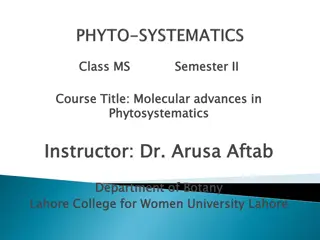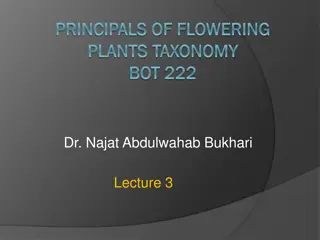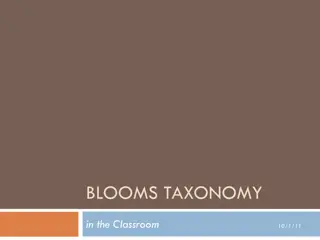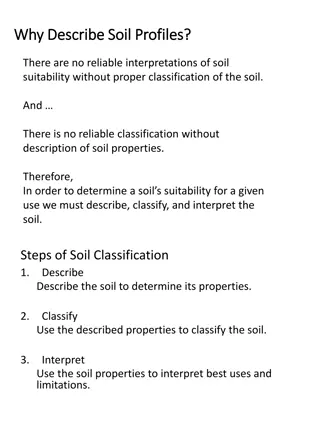Understanding Taxonomy and Scientific Classification
Explore the world of taxonomy and scientific classification, from the discipline of classifying organisms to assigning scientific names using binomial nomenclature. Learn the importance of italicizing scientific names, distinguish between species, and understand Linnaeus's system of classification. Discover the modern classification system and the shift towards a 3-domain system to classify different types of bacteria.
Download Presentation

Please find below an Image/Link to download the presentation.
The content on the website is provided AS IS for your information and personal use only. It may not be sold, licensed, or shared on other websites without obtaining consent from the author. Download presentation by click this link. If you encounter any issues during the download, it is possible that the publisher has removed the file from their server.
E N D
Presentation Transcript
Taxonomy Taxonomy:The discipline of classifying organisms and assigning each organism a universally accepted (scientific name)
What is this animal called? Cougar Mountain Lion Puma Panther Wait . . . So what do we call it?! t_coug4
Assigning Scientific Names To eliminate the confusion of common names, 18th century scientists developed a system to name all organisms in Latin. Binomial Nomenclature: Each species is assigned a two-part scientific name EX: Felis concolor t_coug4
Scientific Names Written in italics The first word is capitalized It is the organism s genus Genus:A group of closely related species The second word is lowercased It is the organism s species Written in Latin
Answer this question in your notes: What is the difference, if any, between these three organisms: Ursusarctos Ursusmaritimus Ailuropodamelanoleuca
Heres a Hint: Click here to submit a letter for the polar bear
Linnaeuss System of Classification Includes seven levels, from largest to smallest: Kingdom Phylum Class Order Family Genus Species
Modern Classification Linnaeus used to group organisms only by their physical characteristics. Using only physical characteristics, how would you classify these organisms?
Modern Classification Now, we use a 3 domain system because of vast differences in different types of bacteria. Current classification system: Domain Kingdom Phylum Class Order Family Genus Species
How Living Things are Categorized All living things are categorized into 3 domains
6 Kingdoms 3 Domains are further divided into 6 Kingdoms Domain Archaea: Kingdom Archaebacteria Domain Bacteria: Kingdom Eubacteria Domain Eukarya: Kingdom Protista Kingdom Fungi Kingdom Plantae Kingdom Animalia
Kingdom Characteristics Chart: Glue the chart you were given into your INB. You can look over this information while we go through the rest of the powerpoint. Kingdom Archaebacteria Eubacteria Protista Fungi Plantae Animalia Cell Type Cell Structures Number of Cells Mode of Nutrition Examples
Kingdom Archaebacteria Cell Type: Prokaryote (no nucleus) Cell Structures: Have unusual cell wall components Number of cells: Unicellular Mode of Nutrition: Autotroph or heterotroph Examples: Methanogens, halophiles
Kingdom Eubacteria Cell Type: Prokaryote Cell Structures: No nucleus, normal sugars in walls Number of Cells: Unicellular Mode of Nutrition: Autotroph or Heterotroph Examples: E. coli, Streptococcus
Kingdom Protista Cell Type: Eukaryote (has a nucleus) Cell Structures: Some have cell walls of cellulose, some have chloroplasts Number of cells: Unicellular or multicellular Mode of Nutrition: Autotroph or heterotroph Examples: Amoeba, Paramecium, giant kelp, diatoms
Kingdom Fungi Cell Type: Eukaryote Cell Structures: Cell Wall of Chitin Number of Cells: Multicellular, some unicellular Mode of Nutrition: Heterotroph Examples: Mushrooms, yeasts
Kingdom Plantae Cell Type: Eukaryote Cell Structures: Cell walls of cellulose, chloroplasts Number of cells: Multicellular Mode of Nutrition: Autotroph Examples: Mosses, ferns, trees and flowering plants
Kingdom Animalia Cell Type: Eukaryote Cell Structures: No cell walls or chloroplasts Number of cells: Multicellular Mode of Nutrition: Heterotroph Examples: Sponges, worms, insects, fish, mammals























